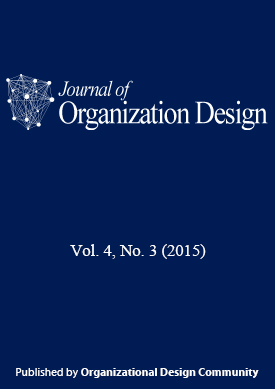How to get the Matrix Organization to Work
DOI:
https://doi.org/10.7146/jod.22549Keywords:
Matrix organization, matrix structure, contingency theory, organization design, junctionsAbstract
Many organizations, both public and private, are changing their structure to a complex matrix in order to meet the growing complexity in the world in which they operate. Often, those organizations struggle to obtain the benefits of a matrix organization. In this article, we discuss how to get a matrix to work, taking a multi-contingency perspective. We translate the matrix concept for designers and managers who are considering a matrix organization and argue that three factors are critical for its success: (1) Strong purpose: Only choose the matrix structure if there are strong reasons for doing so, (2) Alignment among contingencies: A matrix can only be successful if key contingencies are aligned with the matrix’s purpose, and (3) Management of junctions: The success of a matrix depends on how well activities at the junctions of the matrix are managed.References
Appelbaum SH, Nadeau D, Cyr M. 2008a. Performance evaluation in a matrix organization: a case study (Part One). Industrial and Commercial Training 40(5): 236-241.
Appelbaum SH, Nadeau D, Cyr M. 2008b. Performance evaluation in a matrix organization: a case study (Part Two). Industrial and Commercial Training 40(6): 295-299.
Appelbaum SH, Nadeau D, Cyr M. 2009. Performance evaluation in a matrix organization: a case study (Part Three). Industrial and Commercial Training 41(1): 9-14.
Ashby WR. 1956. Introduction to Cybernetics. Chapman & Hall, London, UK.
Axelsson R, Axelsson SB, Gustafsson J, Seemann J. 2014. Organizing integrated care in a university hospital: application of a conceptual framework. International Journal of Integrated Care 14: 1-9.
Bartlett CA, Ghoshal S. 1998. Managing Across Borders: The Transnational Solution (Vol. 2): Taylor & Francis, London, UK.
Boudreau M-C, Loch KD, Robey D, Straud D. 1998. Going global: Using information technology to advance the competitiveness of the virtual transnational organization. Academy of Management Executive 12(4): 120-128.
Burton RM, Obel B, Håkonsson DD. 2015. Organizational Design: A Step-by-Btep Approach. Cambridge University Press, Cambridge, UK.
Davis SM, Lawrence PR. 1977. Matrix. Addison-Wesley, Reading, MA.
Ford RC, Randolph WA. 1992. Cross-functional structures: A review and integration of matrix organization and project management. Journal of Management 18(2): 267-294.
Galbraith JR. 2008. Designing Matrix Organizations that Actually Work: How IBM, Proctor & Gamble and Others Design for Success. Jossey-Bass, San Francisco, CA.
Galbraith JR. 2012. The future of organization design. Journal of Organization Design 1(1): 3-6.
Håkonsson DD, Burton RM, Obel B, Lauridsen,J. 2008. How failure to align organizational climate and leadership style affects performance. Management Decision 46(3): 406-432.
Håkonsson DD, Burton RM., Obel B, Lauridsen JT. 2012. Strategy implementation requires the right executive style: Evidence from Danish SMEs. Long Range Planning 45(2): 182-208.
Hansen MT, Nohria N. 2004. How to build collaborative advantage. MIT Sloan Management Review 46(1): 22-30.
Knez M, Simester D. 2001. Firm-wide incentives and mutual monitoring at Continental Airlines. Journal of Labor Economics 19(4): 743-772.
Levinthal D, Workiewicz M. 2015. Are Two Heads Better than One: The Multi-Authority Form and Organizational Adaptation. Available at: SSRN 2630088.
Malloy R. 2012. Managing effectively in a matrix. Harvard Business Review, August 10, https://hbr.org/2012/08/become-a-stronger-matrix-leade
March JG. 1991. Exploration and exploitation in organizational learning. Organization Science 2(1): 71-87.
Moellekaer A, Pedersen ID, Kirkegaard H., Dissing Sørensen P., Eskildsen JK, Obel B. 2014. Organisationsdesign af de fælles akutmodtagelser. Fremtidens Hospital (pp. 251-266.). Copenhagen: Munksgaard.
Nissen ME. 2014. Organization design for dynamic fit: A review and projection. Journal of Organization Design 3(2): 30-42.
Nissen ME, Burton RM. 2011. Designing organizations for dynamic fit: System stability, maneuverability, and opportunity loss. Systems, Man and Cybernetics, Part A: Systems and Humans, IEEE Transactions 41(3): 418-433.
Park R, Appelbaum E, Kruse D. 2010. Employee involvement and group incentives in manufacturing companies: a multi-level analysis. Human Resource Management Journal 20(3): 227-243.
Sy T, Beach L, D’Annunzio L. 2005. Challenges and strategies of matrix organizations. Human Resource Planning 28(1): 39-48.
Vestring T, Rouse T, Rovit S. 2004. Integrate where it matters. MIT Sloan Management Review 46(1): 15.
Downloads
Published
How to Cite
Issue
Section
License
JOD requires that at least one author of each accepted paper sign a Copyright Transfer Agreement form. Copyright will be transferred to Organizational Design Community when the paper has been accepted.
Articles published in JOD are licensed under a Creative Commons Attribution-NonCommercial-NoDerivs 4.0 Unported License.



